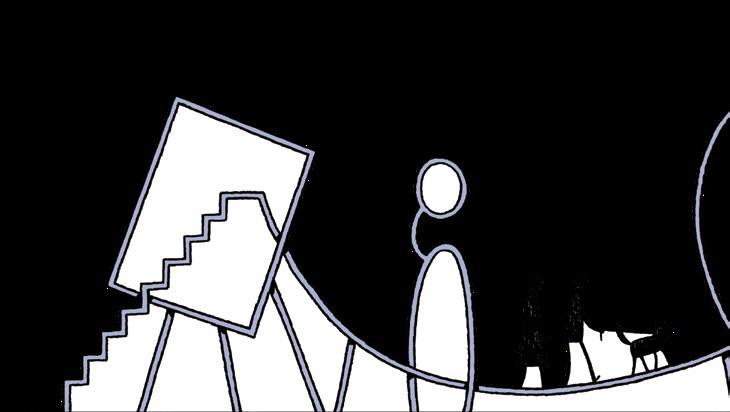sanitation in the capital – so the amount of filth the visitors were likely to excrete was never far from his thoughts. No one who loves Dickens can fail to address the ways in which our greatest novelist can make us cringe. His xenophobia and racism cannot be denied, and Douglas-Fairhurst does not try. He sees nothing sinister in Dickens’s obsession with rescuing ‘fallen’ women, and perhaps there wasn’t anything. But he can see that Dickens’s attitudes to women are generally hard to stomach. An especially fine chapter begins with a splendid picture of Amelia Bloomer, the American journalist wearing her eponymous outfit. Since the very phrase Women’s Emancipation had the writers and cartoonists of Punch in stitches, presumably it amused its readers, too. Douglas-Fairhurst reminds us that, as late as 1876, the New York Times had an editorial that noted ‘a curious nervous disorder peculiar to women’ was ‘an abnormal and unconquerable thirst for trousers’. Dickens was no feminist and considered the very idea of women giving lectures, for example, to be ridiculous. He told readers of Household Words that he would be ‘disturbed’ if his wife attempted the task. Compare and contrast George Eliot’s first full-length novel Adam Bede in which Dinah Morris, the Methodist preacher, mocked at first for her pious oratory, eventually becomes Adam’s wife and even earns the respect of the vicar, Mr Irwine. In 1858, George Eliot received a fan letter from Dickens, for her Scenes of Clerical Life. It began ‘My Dear Sir’. Although they had met frequently when, as Marian Evans, she was editing the Westminster Review (1850-54), neither writer made much impression on the other. Evans/Eliot thought Dickens ‘disappointing … not distinguishedlooking in any way… neither tall nor short’. At this point, I wanted DouglasFairhurst to remind the reader that his height was five foot eight.
Prehistoric lawyer NICOLA SHULMAN Being a Human By Charles Foster Profile £16.99 Charles Foster is a novel version of the superhero – those guys who turn at night into agents of the law with magic powers. Being an agent of the law or, at any rate, a lawyer, is his day job but, in the holidays, he changes his judicial livery for something quite else.
‘I feel you’re someone I can share my dashed hopes and thwarted dreams with’
His last book was about living as a badger. Now he has turned his attention to time travel, returning in succession to the Upper Palaeolithic era (40,000-35,000 years ago), the Neolithic (12,000-3,500) and the Enlightenment (about 350). By far the longest part of the book is the part where he lives, as far as is possible, as an Upper Palaeolithic man. He sets up camp in a wood in Derbyshire, accompanied by his 13-yearold son, Tom. Though in earshot of a major road, they will try to be true to the spirit of the Upper Palaeolithic, according to Foster’s conception of it. So a tarpaulin is OK because ‘no rightthinking Upper Palaeolithic man would turn up his nose at it’. Killing is necessary, but acceptable to the right-thinking UPM only if performed with the respect due to the prey: in this case, a visiting hare. Climbing into a hawthorn tree, they throw stones at it. They miss. Tom goes off to find some squirrels and his father solves the problem in his own way, by entering into an eight-day fast. This kills, so to speak, two hares with one stone, obviating the need to be a decent hunter and, through the psychic effects of the fast, closing in on his central conviction about the Upper Palaeolithic: that the shamanic experience was at its heart. Which is where the magic powers come in. What evidence is there for this? Principally, the human and animal figures in the European cave paintings, which he interprets as representing shamanic beings, ‘just as they assumed or abandoned the animal forms necessary to travel into the spirit world’. For Foster, the Upper Palaeolithic is a time when human consciousness, in the
dawn of its pristine awakening, was able to inhabit, not merely to describe, the co-occupants of its world. And, because UPMs could ‘become’ a tree, or a bird, or a caribou, they held such things in equal regard to themselves. In a cave on the margin of the Severn sea, father and son sit by the fire, watching a bestiary of animals rise and set like constellations on its walls. When they are doing something right, Foster senses the approving presence of an Upper Palaeolithic friend he calls X, with his own son in tow. As they move on to the Neolithic, the parameters of the research change completely. In Foster’s world view, the Neolithic is us. For him, the gap between the first farmers and ‘states, fast food, hedge funds, the subjugation of women, boardroom sycophancy … status, surplus, markets … epidemics of infectious disease’ is one merely of time. The control of fire led to the control and othering of the whole natural world. Once you can draw a straight line, it is a mere hop to the Sykes-Picot Agreement or, indeed, to this kind of direct linkage of distant actions to ultimate consequences. Hence, his investigations into the society of 12,000 years ago can be satisfied by a trip to a modern abattoir and to a fox hunt, where the master ‘sits back in her saddle as in a boardroom chair’. He also visits Meg and Burt on their smallholding in Wales and harries them through the night about ‘acquisitiveness and the relationship between the birth of farming and the birth of avarice’. His inner badger is alive and well, it seems. ‘You’re a fascist, you know that?’ says Meg. As for the Enlightenment, this consists of having dinner with some Oxford The Oldie September 2021 59






































